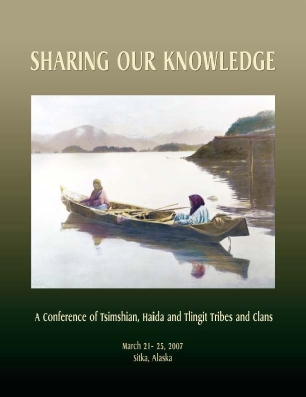Sharing our Knowledge: A Conference of Tsimshian, Haida and Tlingit Tribes and Clans
Funded in part by the National Science Foundation
Sponsors include the Southeast Alaska Native Educators Association and the Sitka Tribe of Alaska

NATIVE CONFERENCE DRAWS HUNDREDS
Half-way through the second day, the last of 400 programs were handed out, and the meeting rooms were filled to capacity. The five-day “Sharing Our Knowledge: A Conference of Tsimshian, Haida and Tlingit Tribes and Clans” attracted academics and artists from throughout North America and as far as St. Petersburg, Russia, and Alaskans, Native and otherwise, from throughout Alaska and the Pacific Northwest.
The conference was held in Sitka, March 21-25, with funding from many sources, including the National Science Foundation. Following the opening ceremonies, nearly 100 presentations and workshops were staged by day, and the evenings were dedicated to traditional music and dance, oratory and poetry readings.
The conference was the latest in the series of what has become the premier scholarly gathering for historians, academics, elders, clan leaders, artists and youth who are involved in the study and documentation of southeast Alaska Native history and culture.
This was the first such gathering in a decade. Earlier conferences were held in Haines/Klukwan (1993), Sitka (1995), Ketchikan (1996), and Sitka (1997), reports Andrew Hope III, the leading force behind the previous gatherings. Hope was joined this year by curator Steve Henrikson (University of Alaska/Alaska State Museum) and anthropologist Sergei Kan (Dartmouth College), who served as co-organizers.
“The amount of positive energy at this conference was impressive,” says Hope. “There was a real, tangible sense of empowerment for everyone. Politics were put aside — it was refreshing.”
The conference was by its very nature non-traditional, yet the unusual meeting format allowed for traditional events — namings, a transfer of at.óow (regalia & other clan heirlooms), and a canoe welcoming ceremony among them—that demonstrated concepts discussed in a more academic manner in other sessions and workshops.
“What makes this event so unique is the mix of old and new,” Henrikson said, “as well as the mix of cultural perspectives between clans, tribes, and others.” Academics, ranging from anthropologists and ethnographers to linguists and specialists in Northwest Coast art, mixed comfortably with elders, young Alaska Native students, and the general public.
“People are hungry for this sort of thing,” says Hope, who was astounded when an over-flow crowd assembled for an evening of storytelling and poetry. “Standing ovations for poetry? It was incredible,” Hope says, still amazed with the enthusiasm extended to presenters who included himself and fellow poets Donna Foulke, Vivian Martindale, Vivian Mork, Dick & Nora Dauenhauer, Martin Strand, Robert Hoffman, and story-tellers Bert Adams and Walter Porter. Hope’s son Ishmael was the master of ceremonies. Several Native dance groups followed. The event ended in the early morning hours of Sunday.
The event was recorded by digital video, and DVDs will be available for a nominal fee. According to the KATH-TV videographers, under contract with the conference, 60 to 70 hours of presentations were recorded. Hope says that the video recordings were made possible with grants from the University of Alaska Southeast, the Juneau School District and the Anchorage School District. DVDs can be ordered by contacting Andy Hope.
Funded in part by the National Science Foundation
Sponsors include the Southeast Alaska Native Educators Association and the Sitka Tribe of Alaska
This material is based upon work supported by the National Science Foundation under Grant No. 0636203. Any opinions, findings, and conclusions or recommendations expressed in this material are those of the author(s) and do not necessarily reflect the views of the National Science Foundation.
